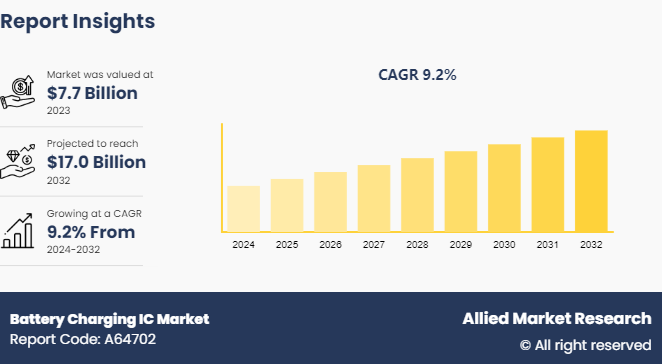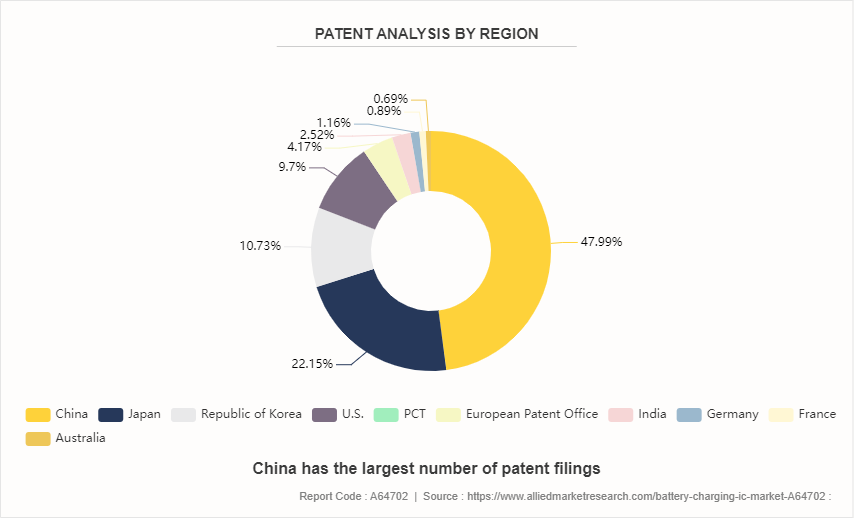Battery Charging IC Market Research, 2032
The Global Battery Charging IC Market was valued at $7.7 billion in 2023 and is projected to reach $17.0 billion by 2032, growing at a CAGR of 9.2% from 2024 to 2032.
A battery charger IC, or integrated circuit, is a semiconductor device designed to regulate and control the charging of rechargeable batteries. These chips are commonly found in portable electronic devices such as smartphones, tablets, and laptops, where reliable power is essential.

The main function of a battery charger IC is to regulate the flow of current from an external power source, such as a wall adapter or USB port, to the battery being charged. The charging process consists of multiple stages, including initial current, constant voltage, and trickle charging. The battery charger IC carefully monitors and controls each stage to ensure safe and efficient charging. Moreover, these chips also include extra features such as temperature monitoring and overcharge protection to safeguard the battery from potential damage.
Key Takeaways
- On the basis of Product type, the Li-Ion/Li-Polymer Battery segment dominated the battery charging IC industry Report in terms of revenue in 2023.
- Based on End-user, consumer electronics dominated the battery charging IC industry in terms of revenue in 2023.
- Region-wise, North America generated the largest revenue in 2023. However, Asia-Pacific is anticipated to grow at the highest CAGR during the forecast period.
Industry Trends:
- In August 2021, the second-generation NU2205 charge pump fast-charging integrated circuit from NuVolta Technologies became the first 100W charge pump fast-charging IC in the whole market. The leading fast-charging IC for 2S batteries with a 4:2 charge pump architecture is NU2205. It is used in flagship smartphones and other mobile devices for ultra-rapid charging applications.
- In order to allow low voltage charging of thin, portable IoT devices like smart displays and wearables like wireless earbuds, ROHM developed a battery charger IC called the BD71631QWZ. Included in this are batteries with various terminal compositions and all-solid/semi-solid variants that employ innovative materials for the electrode portion.
Key Market Dynamics
Supportive government measures, such as renewable energy subsidies and carbon pricing, are driving the growth of the Battery Charging IC market. These incentives and regulations create a favorable environment for the market by encouraging businesses and consumers to embrace renewable energy solutions. Renewable energy subsidies provide financial support, making it more economically viable for companies to invest in battery charging ICs, thereby driving market demand. Similarly, carbon pricing initiatives incentivize the adoption of energy-efficient technologies like battery charging ICs by imposing costs on carbon emissions, pushing organizations to seek cleaner energy alternatives. Therefore, supportive government policies not only accelerate the transition towards sustainable energy but also stimulate market growth for battery charging ICs, contributing to a greener and more efficient energy ecosystem.
However, technical limitations, such as charging speed, efficiency, and heat management, hinder the growth of the market. Slow charging speeds inconvenience users, making electric solutions less appealing compared to traditional counterparts. Inefficient energy conversion leads to higher operational costs and reduced overall performance, diminishing the attractiveness of these technologies. Heat management issues not only reduce the lifespan of components but also pose safety risks, requiring more robust and costly cooling systems.
Furthermore, the rapid growth in electric vehicles (EVs) presents a significant opportunity for the Battery Charging IC market. As the global automotive industry transitions towards electrification, there is a soaring demand for efficient charging solutions to power EV batteries. Battery Charging ICs play a crucial role in managing the charging process, ensuring safety, efficiency, and battery longevity. With governments worldwide implementing stringent emissions regulations and offering incentives to promote EV adoption, the market for Battery Charging ICs is poised for substantial growth. Moreover, technological advancements in fast-charging capabilities and infrastructure development for EV charging stations further enhance the market's potential.
Patent Analysis of the Global Battery Charging IC Market
The global battery charging IC market is segmented according to the patents filed in China, Japan, and the Republic of Korea. China has the largest number of patent filings, owing to suitable research infrastructure. Approvals from these authorities are followed/accepted by registration authorities in many of the developing regions/countries. Therefore, these two regions, China and Japan, have the maximum number of patent filings.

Market Segmentation
The battery charging IC market is segmented into product type, end-user, and region. Based on product type, the market is divided into Linear Battery Chargers, Switching Battery Chargers, μModule Battery Chargers, Pulse Battery Chargers, SMBus/I2C/SPI SPI-controlled battery Chargers, Buck/Boost Battery Chargers, Li-Ion/Li-Polymer Battery, Lead Acid Battery, and Others. By end-user, the market is segmented into Consumer Electronics, Energy & Power, Automotive, and Others. Region-wise, the market is analyzed across North America, Europe, Asia-Pacific, and LAMEA.
Market Segment Outlook
Based on Product type, the Li-Ion/Li-Polymer Battery segment accounts for more than half of the market share. The widespread adoption of lithium-ion and lithium-polymer batteries in various electronic devices, including smartphones, tablets, laptops, and wearables, drives the demand for compatible charging solutions. These battery types offer high energy density, lightweight construction, and longer cycle life compared to traditional alternatives, making them preferred choices for manufacturers and consumers.
Based on end-user, the consumer electronics segment held the highest market share for the battery charging IC industry in 2023, accounting for nearly half of the battery charging IC market share due to the proliferation of smartphones, tablets, laptops, and wearable devices worldwide which drives the demand for efficient charging solutions tailored to these products. As consumers increasingly rely on electronic devices for communication, entertainment, and productivity, the need for fast, safe, and reliable charging becomes paramount. Moreover, continuous technological advancements in consumer electronics, including higher energy capacities and faster charging speeds, fuel the demand for innovative battery charging ICs to meet evolving consumer expectations for convenience and performance.
Regional/Country Market Outlook
Based on region, the battery charging IC industry is analyzed across North America, Europe, Asia-Pacific, and LAMEA. In Asia-Pacific, China accounts for the largest market share for battery charging IC market size by country and is anticipated to grow at the fastest CAGR during the forecast period owing to factors such as the presence of key manufacturing hubs, high demand for consumer electronics and automobile sector, and rapid industrialization and urbanization in countries like China, Japan, South Korea, and India. Moreover, the continuous growth of industrialization, infrastructure development, and technological advancements in the region drives increased demand for the battery charging IC market forecast.
Competitive Landscape
The major battery charging IC manufacturers are Texas Instruments Incorporated, NXP Semiconductors, Analog Devices, Renesas Electronics Corporation, Toshiba Corporation, Vishay, STMicroelectronics, Microchip Technology, Maxim Integrated, and ON Semiconductor. Other players in the battery charging IC industry include Diodes Incorporated, Rohm Co, Ltd., Torex Semiconductor Ltd., and others.
Recent Key Strategies and Developments
- In June 2023, Nordic Semiconductor launched the multi-function nPM1300 Power Management IC with unique system management features.
- In November 2021, ROHM developed a battery charger IC, BD71631QWZ, designed to provide low voltage charging of wearables like wireless earbuds and thin, compact IoT devices such as smart displays powered by rechargeable batteries.
Key Sources Referred
- Semiconductor Industry Association (SIA)
- SEMI
- International Energy Agency
- IEEE Electron Devices Society (EDS)
- U.S. Department of Energy
- Global Semiconductor Alliance (GSA)
- World Economic Forum
- European Semiconductor Industry Association (ESIA)
- Institute of Electrical and Electronics Engineers (IEEE)
- International Battery and Energy Storage Alliance (IBESA)
Key Benefits For Stakeholders
- This report provides a quantitative analysis of the market segments, current trends, estimations, and dynamics of the battery charging IC market analysis from 2024 to 2032 to identify the prevailing battery charging IC market opportunities.
- The market research is offered along with information related to key drivers, restraints, and opportunities.
- Porter's five forces analysis highlights the potency of buyers and suppliers to enable stakeholders to make profit-oriented business decisions and strengthen their supplier-buyer network.
- In-depth analysis of the battery charging IC market segmentation assists in determining the prevailing li ion battery charger IC market opportunities.
- Major countries in each region are mapped according to their revenue contribution to the global market.
- Battery Charging IC Market Share by Company Positioning Facilitates Benchmarking and provides a clear understanding of the present position of the market players.
- The report includes the analysis of regional as well as global battery charging IC market trends, battery charging IC for US market, battery charging IC sector analysis, battery charging IC market data, battery charging IC market insights, battery charging IC market share by companies, battery charger IC with fuel gauge, battery charging IC company list, market segments, application areas, and market growth strategies.
Battery Charging IC Market Report Highlights
| Aspects | Details |
| Market Size By 2032 | USD 17.0 Billion |
| Growth Rate | CAGR of 9.2% |
| Forecast period | 2024 - 2032 |
| Report Pages | 250 |
| By Product Type |
|
| By End User |
|
| By Region |
|
| Key Market Players | Microchip Technology, Toshiba Corporation, NXP Semiconductors, Vishay, Analog Devices, ON Semiconductor, Maxim Integrated, Renesas Electronics Corporation, STMicroelectronics, Texas Instruments Incorporated |
Loading Table Of Content...



